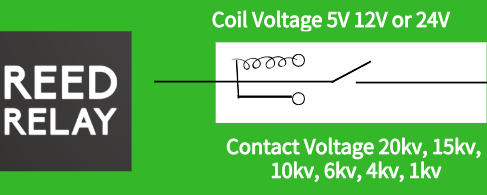Applications of Reed Relays
As a commonly used control component, relays can control larger currents with smaller currents, control higher voltages with lower voltages, control alternating current with direct current, and isolate the control circuit from the circuit being controlled, and are widely used in automatic control, remote control, and protection circuits. The traditional electromagnetic relay is an electrical relay that works by using the circuit within the input circuit to generate suction between the electromagnet core and armature, which is large in size, slow in action, and has very limited reliability and life. With the development of electronic appliances towards miniaturization and miniaturization, new requirements have been put forward for relays, and reed relays, as a new type of relay, can meet the needs of this development in many ways.
Reed switch, also known as reed switch or reed switch, it is invented by Bell Laboratories in the 1940s, a gas-tight sealed magnetically controlled mechanical switch, can be used as a magnetic proximity switch or relay, than the general mechanical switch small size, high speed, long working life, compared with the electronic switch, it also has the characteristics of strong resistance to load shock, high reliability of work.
The reed switch has excellent insulation properties. The insulation resistance of this switch can reach up to 1015Ω, which means that its leakage current can reach the level of 10-15A. Such exceptionally low leakage levels have a wide range of applications in medical electronics, such as probes inserted into the human body or cardiac pacemakers, because these devices require that no leakage current be close to the heart, even if a microampere or sub-microampere current can alter the electrical properties of the critical parts of the heart.
Because the contacts of a reed relay are sealed, they can transform low level signals down to fA (10-15 amps) and nV (10-9 volts), which conventional electromagnetic relays cannot do. Likewise, mechanical relays can only operate for a maximum of a million cycles because their armature operates on a pivot point that is subject to wear and tear, thus reducing its life. In contrast, reed relays do not have any wear parts and therefore can be operated up to a billion times in the signaling condition without any problems.
Features of Reed Relays.
High lifetime (up to one billion operations)
Multi-polar construction, up to 5 poles
Form A (normally open)
Form B (normally closed)
Form C (is a one-way double-throw (SPDT) switch, normally closed)
Form D (is a one-way, double-throw (SPDT) switch, normally open)
Form E (can be switched in both directions)
Low switching resistance (down to 50 mohm)
High insulation resistance (up to 1015ohm)
Can operate up to 10,000 volts
Can carry high currents
Can operate and carry signals down to 10 nV
Can operate and carry signals in the fA range ▪ Can operate and carry signals in the fA range
Can operate and carry signals in the range of fA ▪ Can operate and carry signals up to 6 GHz
Operates in the range of 100 µs to 300 µs
can operate at ultra-specialized temperatures from -55°C to 100°C
Can operate in all different environments such as air, water, vacuum, oil, fuel and dusty environments
withstands shocks up to 200Gs
Can withstand up to 30Gs in vibration from 50Hz to 200Hz
Available in a smaller form factor
Standard pinout
Multiple package configurations
Multiple reed switch options
Custom coil resistance available
Optional magnetic shielding
About SHR Electronic was established in 2010, The company focuses on the development and sales of relays, focuses on manufacturing and production, and serves the customers at home and abroad well with heart and soul.
Our advantages.
▪ Autonomous product development to increase product functions and develop series products for different market customer needs.
▪ Diverse product series to meet the needs of various industries for electronic control system control.
▪ Professional technology, product flexibility, refinement, high efficiency, high quality.
▪ Perfect price system, better adapted to different fields and stages of the market customer groups.
Excellent market service, providing pre-sales and after-sales technical support for product selection and regular training of product expertise.
